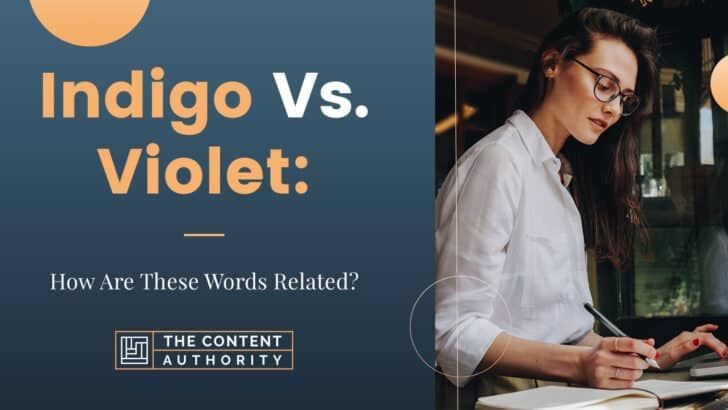If you know the colors of the rainbow, you must be familiar with the words indigo and violet. You are probably wondering, is there a further connection between these words? Let’s look at the overview of indigo vs. violet below before getting deeper into the details.
Indigo is a purplish-blue color or a dye obtained from certain plants with such color. In contrast, violet is a blueish-purple color or a dye of the same color. Violet also refers to a genus of fragrant plants with yellow, purple, or white flowers. Both indigo and violet are rainbow colors.
Indigo and violet are confusing because they are made from the same colors. In fact, there is little difference between these colors. Read on to learn more about these words and their connections.

Definitions Of Indigo And Violet
Most people know indigo and violet as colors on the rainbow. Unfortunately, they cannot define these words beyond this. So, we prepared this definitions section to help you out. Here are the definitions of indigo and violet:
Definitions Of Indigo
Indigo is a color in the rainbow between blue and violet. It ranges from a deep violet blue to dark grayish blue. A more straightforward definition of indigo is a purplish-blue color. Another source defines indigo as a color made from blue and red.
Indigo is a blue dye obtained from certain plants in the Indigofera genus. Some factories also manufacture this color synthetically.
In biology, this word refers to any of the many plants categorized into the Indigofera genus with pinnate leaves and purple or red flowers.
Indigo is also a deciduous subshrub of southeastern Asia with pinnate leaves and red or purple flowers from which the indigo dye is sourced.
As an adjective, this word means “having a deep purplish-blue color” or “having the color pertaining to, or derived from indigo.”
Definitions Of Violet
Violet is a bluish-purple color popular for its presence in the rainbow. Another source defines violet as a reddish-blue color at the opposite end of color red in a spectrum.
A more straightforward definition of violet as a color is “the part of the spectrum farthest from red and after indigo.”
Violet also refers to any chiefly low, stemless, or leafy-stemmed plant of the Viola genus with purple, blue, yellow, or white flowers. Sometimes, this plant contains variegated flowers.
Some sources reveal that this word refers to any such plant except the pansy and viola. Simply put, violet is any of the numerous plants with similar looks to those of genus Viola plants but are distinct. Violet also refers to a flower of any native or wild species of violet as distinguished from the pansy.
In art, violet is a color that combines red and blue in different proportions. This is why it is referred to as “a bluish-purple color.” It is a color midway between red and blue.
In the animal kingdom, violet is any of the numerous species of small violet-coloured butterflies in the Lycaena, rusticus, or allied genera. As an adjective, this word means “having a violet color.”
How To Properly Use Indigo And Violet In A Sentence
Most people only use the words indigo and violet when discussing colors. The definitions above provide you with other contexts where you can use these words. So, you can now diversify how you use these words after reading this article.
Here are additional guidelines on how you can use the words indigo and violet in sentences. Note each usage tip keenly to avoid mistakes you could have avoided.
How To Use The Word Indigo
You can use this word in a sentence to refer to a purplish-blue color. More so, use this term to refer to the following;
- An indigo-coloured dye sourced from specific colors
- A plant from the Indigofera genus
- A synthetically manufactured purplish-blue color
- A deciduous subshrub native to Southeastern Asia with pinnate leaves and purple or red flowers
You can also use this word as an adjective. An adjective modifies a noun. Use it as an adjective to mean:
- Having the color indigo
- Pertaining to indigo (the plant or color)
- Derived from indigo
- Having a deep purplish-blue color
How To Use The Word Violet
Use this word in a sentence to refer to a bluish-purple color. Additionally, you can use it as a noun to mean:
- A genus of fragrant plants with yellow, purple, or white colors
- Plants that look like such (check above) but are taxonomically unrelated
- Plants in the viola genus
- A flower with the violet color
You can also use this word as an adjective to refer to:
- Related to the color midway between red and blue
- Inclining to blueish purple
- Having or related to the color violet
Note: Violet is a popular female name. Therefore, you can also use it in a sentence as a proper noun when referring to a female with the name “Violet.” For example, “We met Violet at the market yesterday night.”
Indigo Vs. Violet: Are They Connected? How?
These colors are definitely connected. The connection between these words is evident in their definitions. These words refer to specific but similar colors. Indigo is a purplish-blue color, while violet is a bluish-purple color.
You can get the color violet by mixing 75% red and 25% blue. In contrast, combining two-thirds blue and one-third red gives you indigo. That means violet has more red than blue, and indigo has more blue than red. Remember that equal proportions of blue and red give purple.
Indigo Vs. Violet: Differences
While these words are related, they also differ. Here are some of their differences:
Pronunciation
These words differ in their pronunciations. The correct way to pronounce the word violet is “/vahy-uh-lit/.” In contrast, the right way to say indigo is “/in-do-goh/.” Note that both words have three syllables.

Spelling And History
The proper spellings for these words are “I.N.D.I.G.O.” and “V.I.O.L.E.T.” When it comes to history, the word violet comes from the 13th-century French word “violete,” meaning “small wild plant with purplish-blue flowers.” It also has Latin roots from the word “voila.”
In contrast, the word indigo came about in the 17th century as a spelling change from the 1550s word ‘indico,” meaning “blue powder from certain plants used as dyes.” It also has Spanish, Dutch, Portuguese, Latin, and Greek roots.
One more thing: Indigo appears before violet on the spectrum. More so, indigo has a higher wavelength than violet.
List Of Examples Of Indigo And Violet Use In Sentences
Start using these words in various contexts, but always remember their definitions. Here are some sentences to start you off:
Example sentences of the word indigo
- I wore my indigo dress to the party last night.
- Jane wore a dark indigo suit to the stakeholders’ meeting last month.
- The indigo shirt cost more than my monthly rent.
- The restaurant demands that all its employees wear indigo t-shirts on Fridays.
- The plant produced an indigo dye.
Example sentences of the word violet
- Faith’s artwork portrays her love for violet.
- Violet is my mother’s favorite color.
- My sister tore my violet dress and hid it from me.
- My husband brought home a bouquet of violets after our argument via text.
- The violet suit will not look good in the flashing lights on the red carpet.
Conclusion
Indigo and violet are the names of colors found in the rainbow. While these colors have many similarities, they are not the same. More so, these words have unrelated definitions, as explained in this indigo vs. violet article.
Shawn Manaher is the founder and CEO of The Content Authority. He’s one part content manager, one part writing ninja organizer, and two parts leader of top content creators. You don’t even want to know what he calls pancakes.

